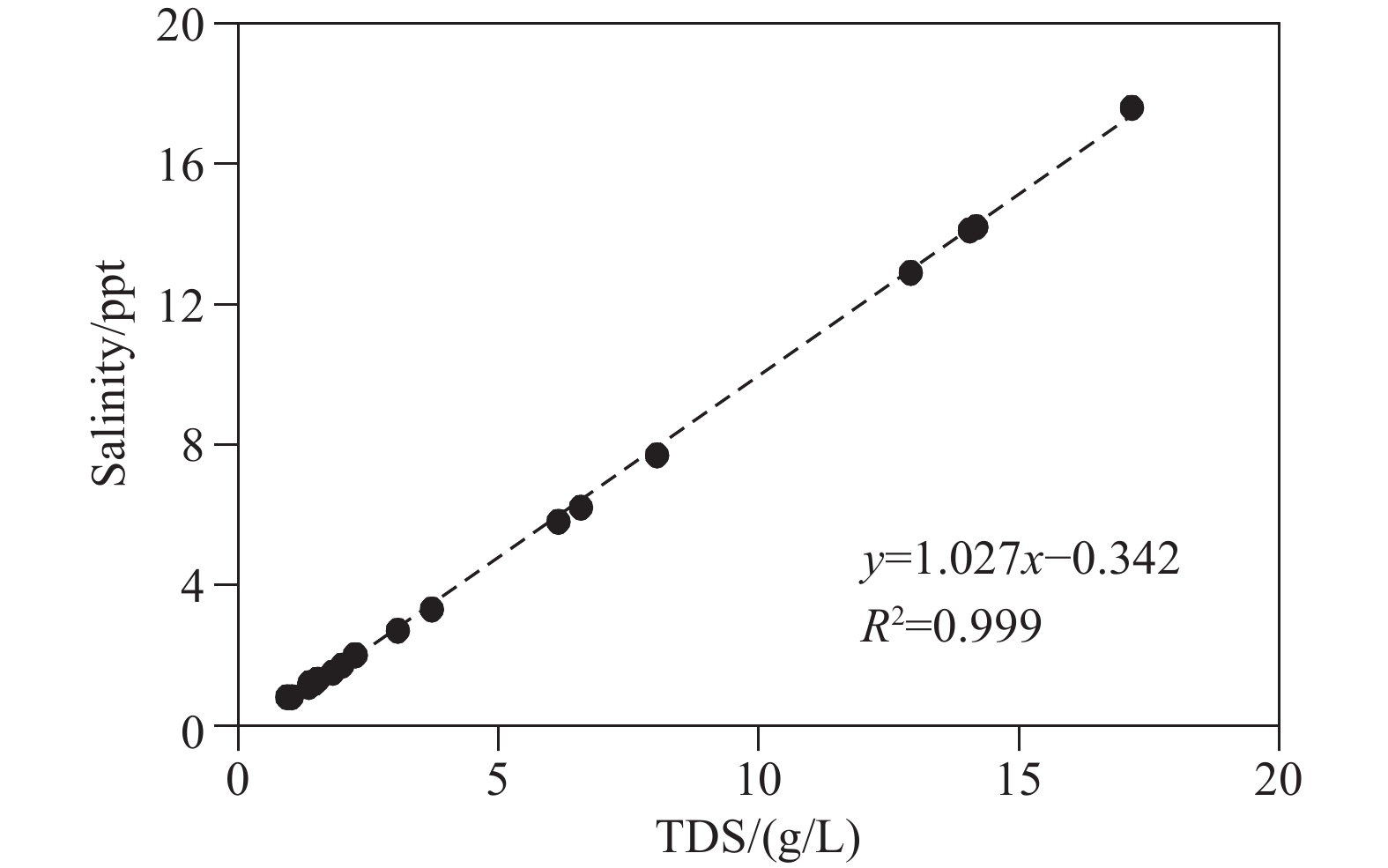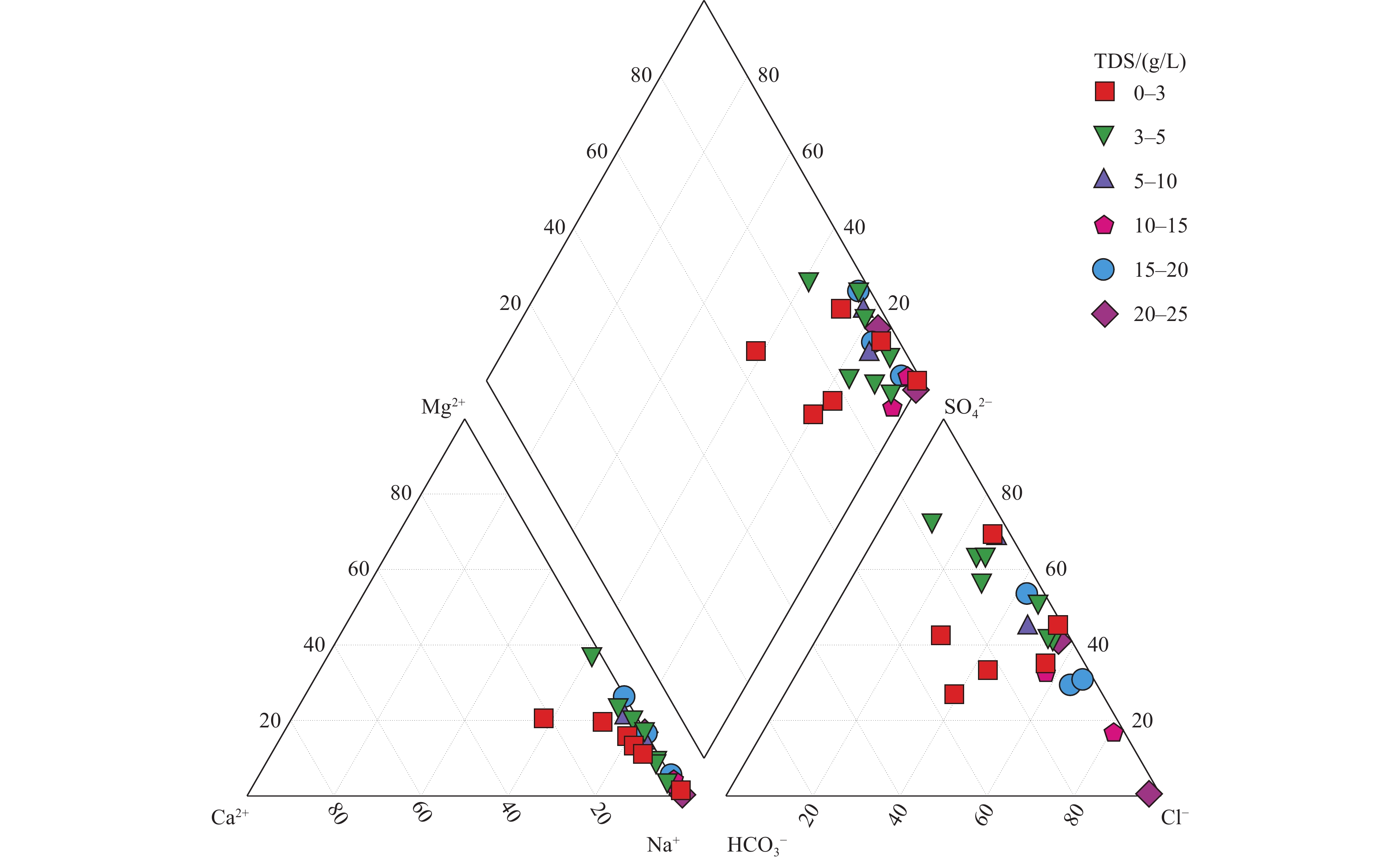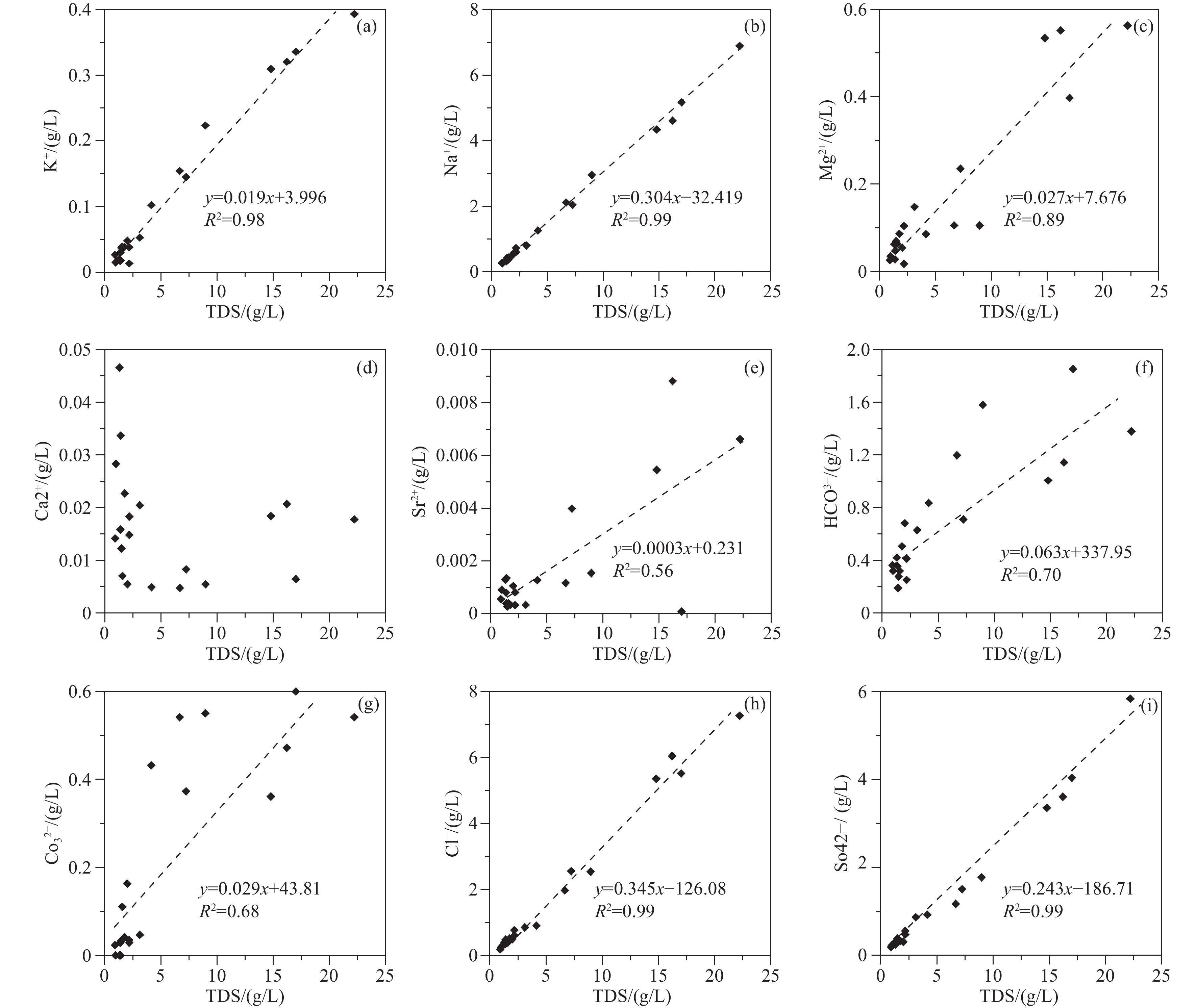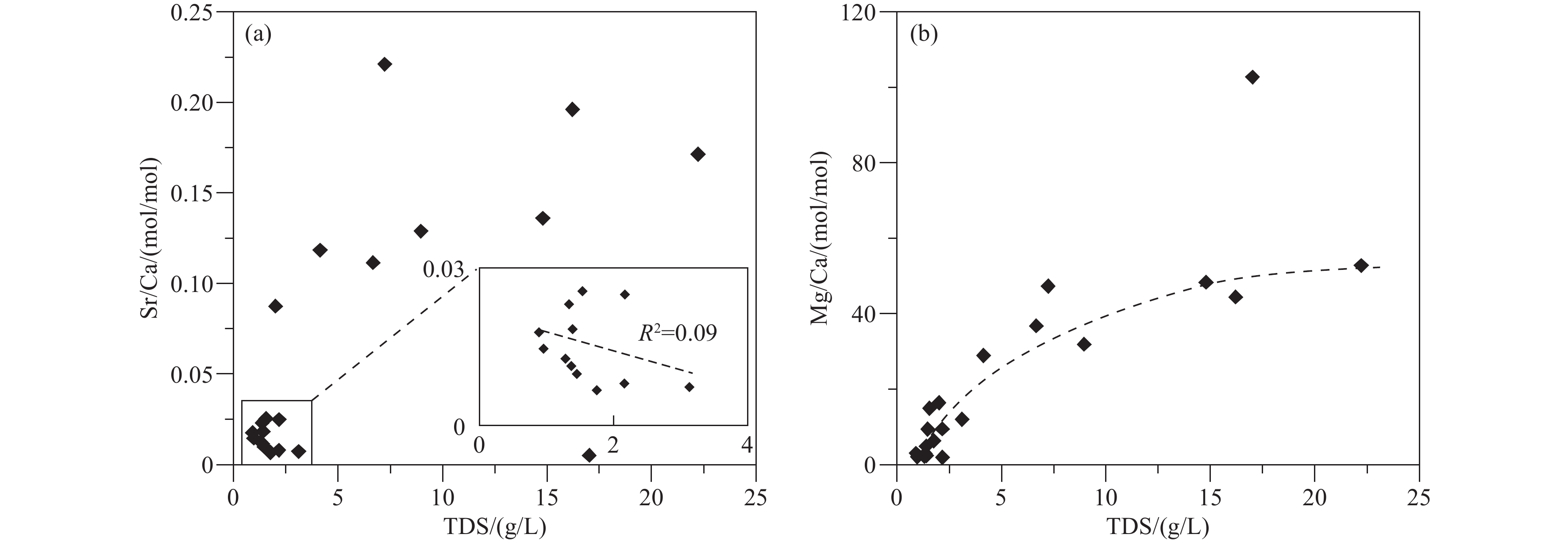| Citation: | Gao-lei Jiang, Zhe Wang, Zhen-long Nie, Zhong-shuang Cheng, Pu-cheng Zhu, Le Cao, Jian-mei Shen, 2024. Hydrochemistry of the lakes in the southern Badain Jaran Desert and its paleosalinity reconstruction, China Geology, 7, 642-652. doi: 10.31035/cg2023057 |
Hydrochemistry of the lakes in the southern Badain Jaran Desert and its paleosalinity reconstruction
-
Abstract
The reconstruction of paleohydrology, especially paleosalinity, is an important component of paleoenvironmental research. Researches on the modern characteristics of lake water chemistry and the relationship between lake salinity and hydrochemistry are the basis of paleoenvironment reconstruction. The modern hydrochemical characteristics and the relationship between ion composition and salinity of modern lakes are the basis of paleosalinity reconstruction. In this study, hydrochemical analysis of 21 lakes in the Badain Jaran Desert (BJD) was carried out. The relationships between the Sr/Ca and Mg/Ca ratios and total dissolved solids (TDS) were analyzed. The results show that Na+, K+, Cl− and SO42− have high positive correlations with TDS, and Mg2+, Sr2+, CO32− and HCO3− have lower correlations with TDS. The Sr/Ca and Mg/Ca ratios do not increase linearly with TDS. Hydrochemical analysis indicates that the studied lakes are in the carbonate precipitation stage and that evaporation is the main factor controlling lake evolution in the BJD. The relationships between the Mg/Ca and Sr/Ca ratios and TDS are mainly influenced by lake evolution stage and the hydrochemical types of the lakes. On the basis of comprehensive previous studies, the factors affecting lake evolution, the Mg and Sr partition coefficients and other hydrochemical parameters that change with lake evolution all affect the relationship between chemical composition and salinity. To reconstruct paleosalinity more accurately, more detailed research on the modern hydrochemical characteristics of lakes and the relationship between the element ratios of carbonates and water salinity should be carried out.
-

-
References
Abbott MB, Wolfe BB, Wolfe AP, Seltzer GO, Aravena R, Mark BG, Polissar PJ, Rodbell DT, Rowe HD, Vuille M. 2003. Holocene paleohydrology and glacial history of the central Andes using multiproxy lake sediment studies. Palaeogeography, Palaeoclimatology, Palaeoecology, 194, 123–138. doi: 10.1016/S0031-0182(03)00274-8. Cao L, Nie ZL, Liu XQ, Wang Z, Meng LQ, Jiang GL. 2017. Hydrochemical cause of lakes’ tufa in Badian Jaran Desert. Journal of Desert Research, 37(5), 1026–1034 (in Chinese with English abstract). doi: 10.7522/j.issn.1000-694X.2016.00101. Cao TJ, Duan XJ, Wang SM, Shen J. 2002. An 800 - year reconstruction of paleosalinity in Daihai Lake water and its implications of climate change. Earth Science Frontiers (China University of Geosciences, Beijing),9(1), 187–192 (in Chinese with English abstract). doi: 10.3321/j.issn:1005-2321.2002.01.023. Chen J, Qian H, Gao YY, Wang HK, Zhang MS. 2021. Insights into hydrological and hydrochemical processes in response to water replenishment for lakes in arid regions. Journal of Hydrology, 581, 124386. doi: 10.1016/j.jhydrol.2019.124386. Chen JS, Li L, Yang J, Wang S, Barry DA, Sheng XF, Gu WZ, Zhao X, Chen L. 2004. Groundwater maintains dune landscape. Nature, 432, 459–460. doi: 10.1038/432459a. Chen L, Wang NA, Wang H, Dong CY, Lu Y, Lu JW. 2012. Spatial patterns of chemical parameters of lakes and groundwater in Badain Jaran Desert. Journal of Desert Research, 32(2), 531–538 (in Chinese with English abstract). doi: 10.1007/s11783-011-0280-z. Chivas AR, De Deckker P, Shelley JMG. 1986a. Magnesium and strontium in non-marine ostracod shells as indicators of palaeosalinity and palaeotemperature. Hydrobiologia, 143(1), 135–142. doi: 10.1007/BF00026656. Chivas AR, De Deckker P, Shelley JMG. 1986b. Magnesium content of non-marine ostracod shells: A new palaeosalinometer and palaeothermometer. Palaeogeography, Palaeoclimatology, Palaeoecology, 54(1), 43–61. doi: 10.1016/0031-0182(86)90117-3. Chivas AR, De Dekker P, Shelley JMG. 1985. Strontium content of ostracods indicates lacustrine paleosalinity. Nature, 316(6025), 251–253. doi: 10.1038/316251a0. Curry B, Henne PD, Mesquita-Joanes F, Marrone F, Pieri V, Mantia TL, Calò C, Tinner W. 2016. Holocene paleoclimate inferred from salinity histories of adjacent lakes in southwestern Sicily (Italy). Quaternary Science Reviews, 150, 67–83. doi: 10.1016/j.quascirev.2016.08.013. Dodd JR. 1965. Environmental control of strontium and magnesium in Mytilus. Geochimica Et Cosmochimica Acta, 29, 385–398. doi: 10.1016/0016-7037(65)90035-9. Dong CY, Wang NA, Chen JS, Li ZL, Chen HB, Chen L, Ma N. 2016. New observational and experimental evidence for the recharge mechanism of the lake group in the Alxa Desert, north-central China. Journal of Arid Environments, 124, 48–61. doi: 10.1016/j.jaridenv.2015.07.008. Dong GR, Gao QZ, Zou XY, Li BS, Yan MC. 1995. Climate changes at southern fringe of the Badain Jaran desert since Pleistocene. Chinese Science Bulletin, 40(13), 423–4237. doi: 10.1007/BF02006258. Dong ZB, Qian GQ, Lv P, Hu GY. 2013. Investigation of the sand sea with the tallest dunes on Earth: China’s Badain Jaran Sand Sea. Earth Science Reviews, 120, 20–39. doi: 10.1016/j.earscirev.2013.02.003. Dong ZB, Wang T, Wang XM. 2004. Geomorphology of the mega-dunes in the Badain Jaran Desert. Geomorphology 60 (1–2), 191–203. doi: 10.1016/j.geomorph.2003.07.023. Engstrom DR, Nelson SR. 1991. Paleosalinity from trace in fossil ostracodes compared with observational records at Devils Lake, North Dakota, USA. Palaeogeography, Palaeoclimatology, Palaeoecology, 295–312. doi: 10.1016/0031-0182(91)90057-X. Eugster HP, Jones BF. 1979. Behavior of major solutes during closed-basin brine evolution. American Journal of Science, 279, 609–631. doi: 10.2475/ajs.279.6.609. Fan JW, Xiao JL, Wen RL, Zhang SR, Huang Y, Yue JJ, Wang X, Cui LL, Li H, Xue DS, Liu YH. 2018. Mineralogy and carbonate geochemistry of the Dali Lake sediments: Implications for paleohydrologucal changes in the East Asian summer monsoon margin during the Holocene. Quaternary International, 527, 103–112. doi: 10.1016/j.quaint.2018.03.019. Gates JB, Edmunds WM, Darling WG, Ma JZ, Pang ZH, Young AA. 2008a, Conceptual model of recharge to southeastern Badain Jaran Desert groundwater and lakes from environmental tracers. Applied Geochemistry, 23, 3519–3534. doi: 10.1016/j.apgeochem.2008.07.019. Gates JB, Edmunds WM, Ma JZ, Scanlon BR. 2008b. Estimating groundwater recharge in a cold desert environment in northern China using chloride. Hydrogeology Journal, 16(5), 893–910. doi: 10.1007/s10040-007-0264-z. Gouramanis C, Wilkins D, Deckker PD. 2010. 6000 years of environmental changes recorded in Blue Lake, South Australia, based on ostracod ecology and valve chemistry. Palaeogeography, Palaeoclimatology, Palaeoecology, 297, 223–237. doi: 10.1016/j.palaeo.2010.08.005. Han PF, Wang XS, Hu XN, Jiang XW, Zhou YY. 2018. Dynamic relationship between lake surface evaporation and meteorological factors in the Badain Jaran Desert. Arid Zone Research, 35(5), 1012–1020. doi: 10.13866/j.azr.2018.05.02. Hardie LA, Eugster HP. 1970. The evolution of closed-basin brines. Mineralogical Society of America, Special Paper, 3, 273–290. Hu HP, Feng JL, Liu JH, Wu XP, Chen F, Zhang JF, Pei LL, Wang KY, Ye CS. 2021. Paleo - hydrochemistry reconstructed from fossil mollusk shells from dammed paleo - lake sediments in the Yarlung Tsangpo valley, Xizang. Applied Geochemistry, 132, 105069. doi: 10.1016/j.apgeochem.2021.105069. Hu WF, Wang NA, Zhao LQ, Ning K, Zhang HX, Sun J. 2015. Water - heat exchange over a typical lake in Badain Jaran Desert, China. Progress in Geography, 34(8), 1061–1071 (in Chinese with English abstract). doi: 10.18306/dlkxjz.2015.08.013. Huang YS, Zheng YS, Heng P, Giosan L, Coolen MJL. 2021. Black Sea paleosalinity evolution since the last deglaciation reconstructed from alkenone - inferred Isochrysidales diversity. Earth and Planetary Science Letters, 564, 116881. doi: 10.1016/j.jpgl.2021.116881. Ito E, Forester R M. 2009. Changes in continental ostracode shell chemistry: Uncertainty of cause. Hydrobiologia, 620(1), 1–15. doi: 10.1007/s10750-008-9622-7. Jia B, Si JH, Xi HY, Qin J. 2021. A characterization of the hydrochemistry and main controlling factors of lakes in the Badain Jaran Desert, China. Water, 13, 2931. doi: 10.3390/w13202931. Jiang GL, Liu LJ, Mao X. 2020. Trace elements in non-marine Ostracods and their application to paleoenvironment reconstruction. Marine Geology & Quaternary Geology, 40(2), 192–199 (in Chinese with English abstract). doi: 10.16562/j.cnki.0256-1492.2019041601. Jiang GL, Nie Z L, Liu Z, Wang Z, Zhao H, Yang JS, Shen JM. 2021a. OSL ages and its hydrological implications of alluvial-diluvial deposits from the southern margin of Badain Jaran Desert. Earth Science, 46(5), 1829–1839 (in Chinese with English abstract). doi: 10.3799/dqkx.2020.148. Jiang GL, Wang NA, Mao X, Zhao H, Liu LJ, Shen JM, Nie ZL, Wang Z. 2021b. Hydrological evolution of a lake recharged by groundwater in the Badian Jaran Desert over the Past 140 years. Frontiers in Earth Science, 9, 721724. doi: 10.3389/feart.2021.721724. Jiang GL, Wang NA, Li ZL, Li M, Su XB, Ning K. 2022a. Distribution pattern of saline minerals in surface sediments from lakes in the Badain Jaran Desert and its implications for climate-environmental reconstruction. Geology in China (in Chinese with English abstract). doi: 10.12029/gc20220304004. Jiang GL, Wang NA, Zhai DY, Li XZ, Mao X, Li M, Liu LJ. 2022b. Distribution pattern of different phenotypes of Limnocythere inopinata (an ostracod) from lakes in the Badain Jaran Desert, northern China. Ecological Indicators, 139, 108965. doi: 10.1016/j.ecolind.2022.108965. Kolpakova MN, Gaskova OL, Naymushina OS, Karpov AV, Vladimirov AG. 2019. Saline lakes of Northern Kazakhstan: Geochemical correlations of elements and controls on their accumulation in water and bottom sediments. Applied Geochemistry, 107, 8–18. doi: 10.1016/j.apgeochem.2019.05.013. Kou Q, Zhu LP, Ju JT, Wang JB, XU T, LI GL, Ma QF. 2022. Influence of salinity on glycerol dialkyl glycerol tetraether-based indicators in Xizang lakes: Implications for paleotemperature and paleosalinity reconstructions. Palaeogeography, Palaeoclimatology, Palaeoecology, 601, 111127. doi: 10.1016/j.palaeo.2022.111127. Li ZL, Chen QJ, Zhang C, Yu QJ, Dong SP, Zhao LQ, Wang NA. 2019. Environmental Significance of the Chemical Composition of Sediments in Groundwater-Recharged Lakes of the Badain Jaran Desert, NW China. Geochemistry, Geophysics, Geosystems, 20, 1026–1040. doi: 10.1029/2018GC007967. Liang XY, Zhao LQ, Xu XB, Niu ZM, Zhang WJ, Wang NA. 2020. Plant phenological responses to the warm island effect in the lake group region of the Badain Jaran Desert, northwestern China. Ecological Informatics, 57, 101066. doi: 10.1016/j.ecoinf.2020.101066. Liu CK, Liu J, Wang XS, Zheng CM. 2016. Analysis of groundwater-lake interaction by distributed temperature sensing in Badain Jaran Desert, Northwest China. Hydrological Processes, 30(9), 1330–1341. doi: 10.1002/hyp.10705. Liu XQ, Dong HL, Rech JA, Matsumoto R, Yang B, Wang YB. 2008. Evolution of Chaka Salt Lake in NW China in response to climatic change during the Latest Pleistocene-Holocene. Quaternary Science Reviews, 27, 867–879. doi: 10.1016/j.quascirev.2007.12.006. Lu Y, Wang NA, Li GP, Li ZL, Dong CY, Lu JW. 2010. Spatial distribution of lakes hydro - chemical types in Badain Jaran Desert. Journal of Lake Science, 22(5), 774–782 (in Chinese with English abstract). doi: 10.18307/2010.0521. Ma JZ, Chen FH, Zhao H. 2004. Change on climate and groundwater recharge from geochemical records of unsaturated zone in the Badain Jaran Desert in the recent 1000 years. Chinese Science Bulletin, 49(1), 22–27. doi: 10.3321/j.issn:0023-074X.2004.01.004. Ma N, Wang NA, Zhao LQ, Zhang ZY, Dong CY, Shen SP. 2014. Observation of mega-dune evaporation after various rain events in the hinterland of Badian Jaran desert. Chinese Science Bulletin, 59, 162–171. doi: 10.1007/s11434-013-0050-3. Ma SH, Li ZL, Wang NA, Ning K, Li M. 2015. Mineralogical assemblage in surface sediments and its formation mechanism in the groundwater recharged lakes: A case study of lakes in the Badain Jaran Desert. Journal of Lake Sciences, 27(4), 727–734 (in Chinese with English abstract). doi: 10.18307/2015.0422. McCormack J, Viehberg F, Akdemir D, Immenhauser A, Kwiecien O. 2019. Ostracods as ecological and isotopic indicators of lake water salinity changes: the Lake Van example. Biogeosciences, 16, 2095–2114. doi: 10.5194/bg-2018-476. Michelson AV, Boush LP. 2017. A quantitative inference model for conductivity using non-marine ostracode assemblage on San Salvador Island, Bahamas: Paleosalinity records from two lakes. Palaeogeography, Palaeoclimatology, Palaeoecology, 477, 27–39. doi: 10.1016/j.palaeo.2017.04.002. Mischke S, Almogi-Labin A, Ortal R, Rosenfeld A, Schwab MJ, Boomer I. 2010. Quantitative reconstruction of lake conductivity in the Quaternary of the Near East (Israel) using ostracods. Journal of Paleolimnology, 43, 667–688. doi: 10.1007/s10933-009-9359-y. Mischke S, Herzschuh U, Massmann G, Zhang C. 2007. An ostracod-conductivity transfer function for Xizang lakes. Journal of Paleolimnology, 38, 509–524. doi: 10.1007/s10933-006-9087-5. Odum HT. 1951. Notes on the strontium content of sea water, celestite radiolaria, and strontium snail shells. Science, 114, 211–213. doi: 10.1126/science.114.2956.211. Rucker JB, Valentine JW, 1961. Salinity response of trace element concentration in Crassostrea virginica. Nature, 190, 1099–1100. doi: 10.1038/1901099a0. Sampei Y, Matsumoto E, Dettman DL, Tokuoka T, Abe O. 2005. Paleosalinity in a brackish lake during the Holocene based on stable oxygen and carbon isotopes of shell carbonate in Nakaumi Lagoon, southwest Japan. Palaeogeography, Palaeoclimatology, Palaeoecology, 224, 352–366. doi: 10.1016/j.palaeo.2005.04.020. Shen J, Wang SM, Matsumoto R, Zhu YX. 2000. A preliminary study on palaeosalinity recovery in Daihai, Inner Mongolia. Science Bulletin, 45(17), 1885–1889. doi: 10.3321/j.issn:0023-074X.2000.17.017. Song SH, Nie ZL, Geng XX, Shen X, Wang Z, Zhu PC. 2023. Response of runoff to climate change in the area of runoff yield in upstream Shiyang River Basin, Northwest China: A case study of the Xiying River. Journal of Groundwater Science and Engineering, 11(1), 89–96. doi: 10.26599/JGSE.2023.9280009. Sun J, Hu WF, Wang NA, Zhao LQ, An R, Ning K, Zhang XH. 2018. Eddy covariance measurements of water vapor and energy flux over a lake in the Badain Jaran Desert, China. Journal of Arid Land, 10(4), 517–533. doi: 10.1007/s40333-018-0057-3. Turich C, Freeman KH. 2011. Archaeal lipids record paleosalinity in hypersaline systems. Organic Geochemistry, 42, 1147–1157. doi: 10.1016/j.orggeochem.2011.06.002. Van der Meeren T, Ito E, Verschuren D, Almendinger JE, Martens K. 2011. Valve chemistry of Limnocythere inopinata (Ostracoda) in a cold arid environments-implications for paleolimnological interpretation. Palaeogeography, Palaeoclimatology, Palaeoecology, 306, 116–126. doi: 10.1016/j.palaeo.2011.04.006. Wang DC. 1980. Hydrogeology. Beijing: Geological Publishing House, 49–54. Wang HL, Zhen MP. 2010. Preliminary study of the correlation between hydrochemistry and salinity of lakes in the Qinghai-Xizang Plateau. Acta Geologica Sinica, 84(10), 1518–1522 (in Chinese with English abstract). doi: 10.1017/S0004972710001772. Wang LJ, Wang Z, Jiang GL, Nie ZL, Shen JM, Song SH. 2024. Variations in evaporation from water surfaces along the margins of the Badain Jaran Desert over nearly 60 years and influencing factors. Journal of Groundwater Science and Engineering, 12(3), 253–263. doi: 10.26599/JGSE.2024.9280019. Wang NA, Ning K, Li ZL, Wang YX, Jia P, Ma L. 2016. Holocene high lake-levels and pan - lake period on Badian Jaran Desert. Science China Earth Sciences, 59, 1–10. doi: 10.1007/s11430-016-5307-7. Wang Z, Wang LJ, Shen JM, Nie ZL, Meng LQ, Cao L, Wei SB, Zeng XF. 2021. Groundwater characteristics and climate and ecological evolution in the Badain Jaran Desert in the southwest Mongolian Plateau. China Geology, 4, 421–432. doi: 10.31035/cg2021056. Wang Z, Wang LJ, Shen JM, Nie ZL, Cao L, Meng LQ. 2024. Groundwater recharge via precipitation in the Badain Jaran Desert, China. Journal of Groundwater Science and Engineering, 12(1), 109–118. doi: 10.26599/JGSE.2024.9280009. Williams WD. 1966. The relationship between salinity and Sr/Ca in the lake water. Marine and Freshwater Research, 17, 169–176. doi: 10.1071/MF9660169. Wu D, Zhou AF, Zhang JW, Chen JH, Li GQ, Wang Q, Chen L, Madsen D, Abbott M, Cheng B, Chen FH. 2020. Temperature-induced dry climate in basins in the northeastern Xizang Plateau during the early to middle Holocene. Quaternary Science Reviews, 237, 106311. doi: 10.1016/j.quascirev.2020.106311. Wu Y, Wang NA, Zhao LQ, Zhang ZY, Chen L, Lu Y, Lv XN, Chang JL. 2014. Hydrochemical characteristics and recharge sources of Lake Nuoertu in the Badian Jaran Desert. Chinese Science Bulletin, 59, 886–895. doi: 10.1007/s11434-013-0102-8. Xu XN, Wang Y, Shen J, Wang Y. 2012. Discussion on feasibility of paleosalinity reconstruction of Lake Qinghai water by variations in body length of Ostracod valves. Acta Sedimentologica Sinica, 30(6), 1072–1079 (in Chinese with English abstract). Yang QC, Jochum KP, Stoll B, Weis U, Börner N, Schwalb A, Frenzel P, Scholz D, Doberschütz S, Haberzettl T, Gleixner G, Mäusbacher R, Zhu LP, Andreae MO. 2014. Trace element variability in single ostracod valves as a proxy for hydrochemical change in Nam Co, central Xizang, during the Holocene. Palaeogeography, Palaeoclimatology, Palaeoecology, 399, 225–235. doi: 10.1016/j.palaeo.2014.01.014. Yang XP, Williams MAJ. 2003. The ion chemistry of lakes and late Holocene desiccation in the Badain Jaran Desert, Inner Mongolia, China. Catena, 51, 45–60. doi: 10.1016/S0341-8162(02)00088-7. Yang XP. 2000. Discovery of calcareous cementation layers and their paleoclimatic implications in the Badain Jaran Desert. Quaternary Science, 20(3), 295–297 (in Chinese with English abstract). doi: 10.3321/j.issn:1001-7410.2000.03.010. Yu C, Wu LJ, Zhang YL, Wang XY, Wang ZC, Zhang Z. 2022. Effect of groundwater on the ecological water environment of typical inland lakes in the Inner Mongolian Plateau. Journal of Groundwater Science and Engineering, 10(4), 353–366. doi: 10.19637/j.cnki.2305-7068.2022.04.004. Yu LS, Liu HB, Wan F, Hu ZF, Luo HD, Zhang XW. 2021. Geochemical records of the sediments and their significance in Dongping Lake Area, the lower reach of Yellow River, North China. Journal of Groundwater Science and Engineering, 9(2), 140–151. doi: 10.19637/j.cnki.2305-7068.2021.02.006. Zhai DY, Xiao JL, Zhou L, Wen RL, Chang ZG, Wang X, Jin XD, Pang QQ, Itoh S. 2011. Holocene East Asian monsoon variation inferred from species assemblage and shell chemistry of the ostracodes from Hulun Lake, Inner Mongolia. Quaternary Research, 75, 512–522. doi: 10.1016/j.yqres.2011.02.008. Zhang EL, Jones R, Bedford A, Langdon P, Tang HQ. 2007. A chironomid-based salinity inference model from lakes on the Xizang Plateau. Journal of Paleolimnology, 38, 477–491. doi: 10.1007/s10933-006-9080-z. Zhang EL, Shen J, Wang SM, Yin Y, Zhu YX, Xia WL. 2004. Quantitative reconstruction of the paleosalinity at Qinghai Lake in the past 900 years. Chinese Science Bulletin, 49(7), 697–701. doi: 10.1360/03wd0334. Zhang JW, Holmes JA, Chen FH, Qiang MR, Zhou AF, Chen S. 2009. An 850-year ostracod-shell trace-element record from Sugan Lake, northern Xizang Plateau, China: Implications for interpreting the shell chemistry in high-Mg/Ca waters. Quaternary International, 194, 119–133. doi: 10.1016/j.quaint.2008.05.003. Zhang PX, Zhao BZ, Qian GM, Li HJ, XU LM. 1994. The study of paleoclimatic parameter of Qinghai Lake since Holocene. Quaternary Sciences, 3, 225–2378 (in Chinese with English abstract). Zhang XL, Luo X, Jiao JJ, Li HL, Lian EG, Yang SY, Kong FC, Kuang XX, Zuo JC. 2021. Hydrogeochemistry and fractionation of boron isotopes in the inter-dune aquifer system of Badian Jaran Desert, China. Journal of Hydrology, 595, 125984. doi: 10.1016/j.jhydrol.2021.125984. Zhang HS, Cai WT, Guo F, Bian C, Liu FD, Zhang L, Liu JW, Zhao M. 2023. Microbial community composition and environmental response characteristics of typical brackish groundwater in the North China Plain. China Geology, 6(3), 383–394. doi: 10.31035/cg2022073. Zhu JF, Wang NA, Chen HB, Dong CY, Zhang HA. 2010. Study on the boundary and the area of Badain Jaran Desert based on remote sensing imagery. Progress In Geography, 29(9), 1087–1094 (in Chinese with English abstract). doi: 10.3724/SP.J.1084.2010.00199. -
Access History

-
Figure 1.
Map of the Badain Jaran Desert (a) and the study lakes (b).
-
Figure 2.
Monthly mean temperature and precipitation of the Badain Jaran Desert during 1960–2018.
-
Figure 3.
Relationship between TDS and salinity using hand-held water quality analyzer.
-
Figure 4.
Piper diagram of the chemical composition of the lakes in the southern BJD.
-
Figure 5.
Relationship between different ion contents and TDS.
-
Figure 6.
Relationship between Sr/Ca (a) and Mg/Ca (b) ratios and TDS.
-
Figure 7.
Gibbs plots indicating dominant processes for the formation of lake water.
-
Figure 8.
Ca2+ and HCO3− (a) and Mg2+ and SO42− (b) as a function of Cl− content in lake water. The solid line corresponds to the positions of points expected by simple evaporation (Hardie LA et al., 1970).
-
Figure 9.
Saturation index of minerals in the lakes of the study area.

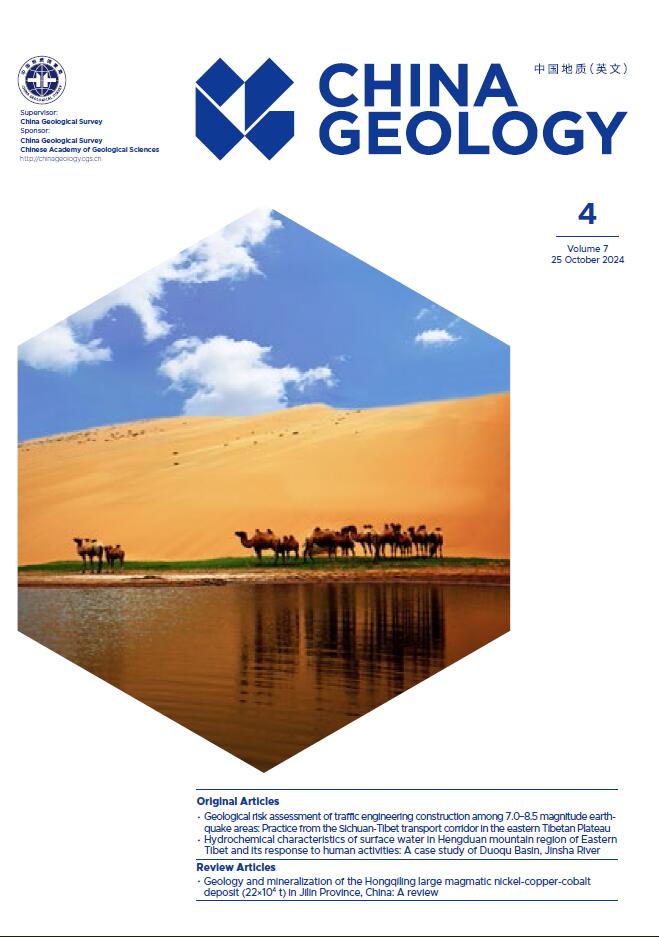



 DownLoad:
DownLoad:

